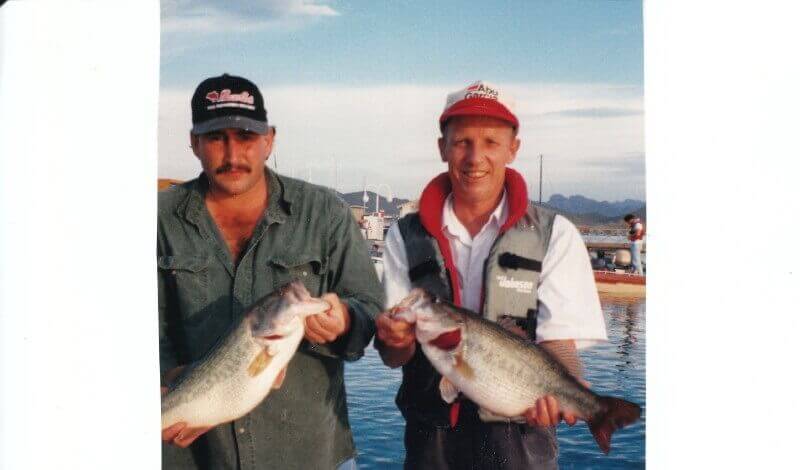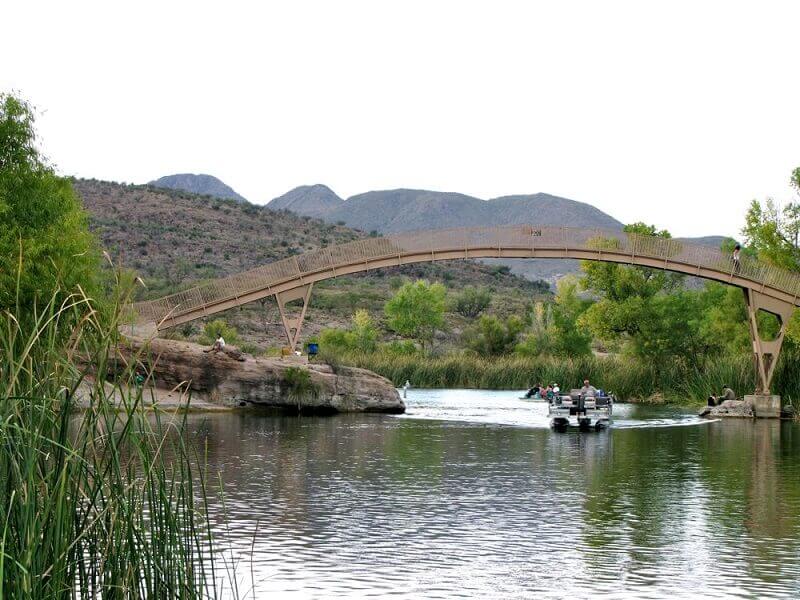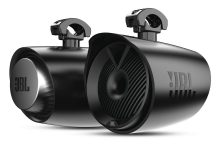Arizona Angler Knows Patagonia Lake So Well
Patagonia Lake is a small reservoir about an hour south of Tucson. Formed by damming Sonoita Creek, this beautiful little lake offers good crappie, catfish, and bass fishing in Southern Arizona. The terrain around Patagonia is very different from the deserts surrounding the central Arizona lakes. Patagonia is at an elevation of 3,750 feet, and the surrounding country is grassy hills and scrub oak and juniper.

Dan Marzano Takes Us To Patagonia
Patagonia looks more like a midwestern lake than an Arizona lake–thick reeds and cattails line much of the shore, and weedbeds are thick in the shallower areas. Coues deer, javelina, wild burros, and many different kinds of birds can often be spotted on the hills around the lake. Also, fishing Patagonia is a little different from fishing a desert reservoir.
Click here to see a list of AZ Lakes AZ Pros Stories on Western Outdoor Times.
Anyone who fished bass tournaments in the early ‘90s will remember an angler named Dan Marzano. A Tucson resident, he loved fishing Patagonia but also fished bass tournaments all over the state and made quite a name for himself. He took us to Patagonia one late summer day to show us the ropes.
A Pleasant Walking Trail
On the day that we visited Patagonia, the air temperature was around 90 degrees, and the water temperature was 76. There wasn’t a cloud in the sky and there were a lot of boats on the water, as well as plenty of shore fishermen. Patagonia has a very pleasant 6/10 mile walking trail that leads from the loop at the end of the road over to Sonoita Creek.
The creek winds through some pretty thick trees before spreading out into a grassy delta with two main branches, so it’s a very nice place to sit and fish. Four Coues deer were sharing the grass with some cattle the day we were there.
Launch Ramps, Boat House
There are two launch ramps at Patagonia, and we launched at the marina, which is situated at the far end of a little bay on the south side of the lake. There is a store there, and you can even rent a small boat if you need to. On the right side of the bay, as you’re heading out, there is a boat house where Marzano said he has often caught good numbers of crappie.
The marina bay narrows down just before it opens back out into the main lake, and an arched footbridge has been built across the lake at this point. The bridge runs from one large rock formation to another and is quite pretty. Fishermen lounge on the boulders in the shade of the bridge while they watch their lines.
A Good Place To Fish In Winter

As you turn right after passing under the bridge, heading toward the east end of the lake, there is a large shelf underwater just at the turn where the bay opens into the main lake. This is a part of the rock formation that the bridge sits on, and there is a good drop-off about forty feet from shore. This is a good place to fish in winter, Marzano says. He likes to fish plastic worms, and this shelf with the drop-off is the perfect place for a worm fisherman. A four-inch grape worm is one of Dan’s favorites and in December and January, finesse fishing is the best way to catch fish.
He works these little worms very slowly on the bluffs and drop-offs along the creek channel. A crankbait worked along these areas will work, too, a lot of times. He chooses crankbaits that run about eight feet deep, and tries to keep them ticking the submerged treetops in winter. A jig and pig will also catch bass on the drop-off by the bridge, according to Marzano. Purple and blue seem to be the colors that the Patagonia bass prefer, no matter what time of year it is.
Swimming Beach On South Shore
Moving on down the bank on the south shore, you come to the swimming beach. This beach is buoyed off, and you can’t fish inside the buoys when people are swimming there. This is a good worming spot, says Marzano, and an excellent place to fish a spinnerbait at night. Spinnerbait fishing at night is particularly good at Patagonia, and for cranking on summer nights, a Bagley’s DB3 in Hot Craw is the best lure ever.
Dan Says: ‘Always A Bite’
At the end of the lake is where Sonoita creek enters, and the water is shallow and weedy. This is spinnerbait, topwater, and jerkbait territory. “At Patagonia there is always a bite in less than five feet of water,” Dan stated, and proceeded to put his money where his mouth was by catching a nice bass on a suspending Rogue. Dan caught some more on his Rogue (clown color), and insisted that the fishing would be even better as evening approached, when the topwater bite would begin. Buzzbaits, grubs, Pop-R’s, and other topwater lures fished over the weeds in this end of the lake are real producers.
The fishing by the creek isn’t that great during the cold months, but when winter ends the bass move toward the incoming creek waters and you can catch one after another on small blade baits like Super Dupers, Roostertails, and Mepps. Marzano added that in the deeper parts of the lake, Patagonia is “a dynamic spoon lake in winter”. In summer, the creek area is one of the best spots on the lake for catfish.
Marzano Knows This Lake So Well
Moving on to the north shore, the banks are cattails and trees, and pitching small purple worms, spinnerbaits, or jigs is the order of the day from April through October. When you pitch to the reeds, says Dan, stay out a little way because of the clear water, and pitch your lure right up to the plants. Let the lure fall, hop it once or twice, and if you don’t get bit, move on. The fish always take the lure on the fall.
One stretch of this reedy bank has a lot of wood sticking out of the water in front of it, and this is an excellent place to throw a spinnerbait. Marzano knows this lake so well that he practically has each individual piece of wood named, and can recite lengthy lists of fish caught off each stump and log.
As you start to reach the point where you are directly across from the entrance to the marina, the bank changes. Huge boulders form the shore now, and this is one of the best places on Patagonia for big fish. “Crankbaits like a Poe’s 300 or 400, a Bagley’s DB3, or a Mann’s 15+ are dynamite on this rock,” say Dan, “especially first thing in the morning.” Spinnerbaits are good here, too.
Dynamite For Bass And Crappie
Still heading west along the north shore, past the big rock bank, you come to another area where the shoreline is covered with cattails. This is a submerged bluff, and the creek channel below is still lined with huge cottonwood trees. The shore runs out relatively flat, then suddenly drops off, and you can see the trees beneath you on your graph. This is a dynamite spot not only for bass, but for crappie. We hooked two huge bass on our crappie rods while fishing these trees, and both fish broke off the 4-pound-test by diving into the thick branches.
Just past this tree-filled fish heaven the shore begins to curve north and east into Ash Canyon. This cove is a super area for crappie and bass, and in the summer, you can sometimes catch big bass on buzzbaits in the middle of the day at the back of this cove. The right side of this arm as you are moving in is a little steeper, and the cuts on this side are some of Dan’s favorite crappie spots. The crappie at Patagonia prefer yellow and white jigs, and use of live minnows is forbidden on the lake. Dan uses yellow/white tube jigs on 1/32-ounce jigheads for crappie.
Catch Bass All Year Long
Once you come out of Ash Canyon, you’re almost at the end of the lake. This end is the skiing half of Patagonia — the east end is totally no wake. The spillway can be an awesome place for buzzbaits, especially from June through September. Mostly, though, Marzano pitches his purple Lucky Strike worms to the reeds. In winter, the channel of Ash Canyon is good to fish with finesse lures and jigs.
In general, you can catch bass at Patagonia all year long on spinnerbaits and jerkbaits. In summer and fall he uses suspending jerkbaits, but switches to floating ones in spring. Winter is pig-and-jig time, and also crankbaits and worms. But worms work all year in the reeds at Patagonia, and there are plenty of those around.
For Anglers At All Skill Levels
November and December are the best months for crappie fishing, according to Dan, and the monsoon season is best for catfish. Bass fishing, like bass fishing everywhere, is just about as good as the bass fisherman, but Patagonia offers opportunities for anglers at all skill levels, with beautiful scenery thrown in free of charge.
Getting To Patagonia And Details There
You can get to Patagonia by taking I-10 east to I-19 at Tucson and going to Nogales. At Nogales, head north on Highway 82 to the lake. A more scenic route is to keep going east on I-
10 past I-92 to Highway 83 at Pantano. Turn south here to Sonoita, then catch Highway 82 to the lake.
There is a $15-$20 entry fee per vehicle to Patagonia Lake, and there is no entry from 10:00 pm to 4:00 am.
There are 105 developed campsites at Patagonia, and you can reserve online or by calling 877-MY-PARKS. There is also a store, marina, restrooms and showers, and picnic ramadas. There are also 12 boat-in sites with picnic tables and fire rings. Some have portable rest rooms.
Please scroll to the bottom of any article and leave us your outdoor experiences in the “Comments” section.
More Arizona Fishing Resources
Click here to see a list of AZ Lakes AZ Pros Stories on Western Outdoor Times.
Click here to see a list of AZ Lakes AZ Pros Stories on Arizona Boating And Watersports
Arizona Rivers And Streams Publishers Note
© 2005-2022 Arizona Boating & Watersports. All Rights Reserved.































